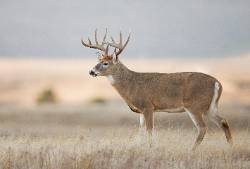Animal Damage to Landscape Plants

While wildlife can be cute and cuddly looking, they can cause severe damage to our landscape plants under the right conditions. It wasn’t till one winter in North Dakota that I saw the true extent of the damage that mice, voles, and other rodents can cause in a landscape. That particular winter, we had a mild fall, then a series of blizzards dumped 70+ inches of snow in a month on top of the ground, which, due to the insulation from the snow, froze for the winter. The small furry critters tunneled at ground level and, unfortunately, chewed completely around the trunks of many small trees in one yard, leading to the eventual death of a large portion of their trees. They never worried about protecting their trees since they hadn’t had issues in the past, which had some sad and expensive consequences. We should take a few steps to keep mice from becoming an issue this winter.
The first step is to remove stacks of lumber, woodpiles, brush, etc, that rodents could hide in to help reduce their living options. Mice won’t travel long distances, especially without cover, so removing the hiding places will reduce the chances you have issues. I would also recommend keeping mulch away from the trunks of trees to keep mice from having another hiding place. If you want to mulch around sensitive plants, there are options to keep them safe. You can put a physical barrier around tree trunks or other plants to serve as protection. Plastic tree tubes, wraps, or chicken wire can keep small critters away from your plants. If we have a heavy snowfall or enough snow this winter where the snow might be taller than your physical barrier, I recommend going out and making your barrier taller.
Chemical repellants can also be an option if a physical barrier isn’t possible. They make repellants for rodents and deer that work by taste or smell. We know deer can cause quite a bit of damage to smaller trees, so a repellant can be a great option to keep those plants safe. Chemical taste repellents work by making the bark taste bad so that animals looking for an easy meal look elsewhere. Apply any taste repellent from the soil well past the usual snow level. Spray the trunk and low-hanging branches that rabbits might be able to reach. If snow drifts unusually high around valuable plants, a midwinter spray might be necessary to extend protection higher up the plants. Taste repellents can be reasonably effective if animals have other food sources available nearby. Smell repellants are the other option that can be effective and work via a smell that the animals don’t like, such as blood meal or predator urine. Repellents can be a good option, but if animal populations are so high, the weather so severe, or food so scarce that the animals are nearing starvation, they will ignore even the best repellant to get food to eat.

Have questions? Contact our office where our Horticulture Extension Agent will assist you with questions.
Phone: (316) 321-9660
Email: callae@ksu.edu